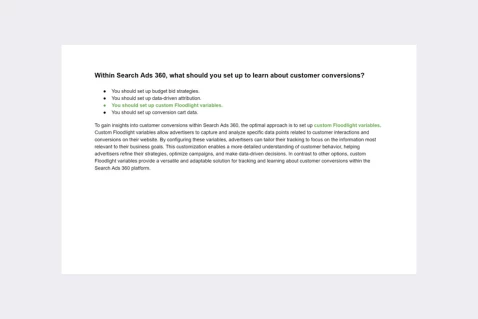Your agency client is wondering what metrics between Search Ads 360 and Google Analytics 4 are different but still complimentary. What's your answer?
Your answer is conversions.
Your answer is engagements.
Your answer is return on ad spend (ROAS).
Your answer is return on investment (ROI).
Certification program: 👉 Google Search Ads 360 certification exam
Explanation: The metric between Search Ads 360 and Google Analytics 4 that is different but still complementary is “conversions.” While both platforms track conversions, the definition and tracking mechanisms may vary. Search Ads 360 typically focuses on ad-driven conversions, emphasizing actions directly influenced by advertisements. On the other hand, Google Analytics 4 provides a more holistic view, encompassing a broader range of website interactions and conversions beyond ad-specific activities. Despite this difference, these metrics are complementary, offering insights into different aspects of user behavior and campaign performance. Unlike options such as engagements, return on ad spend (ROAS), or return on investment (ROI), choosing conversions highlights the synergy between Search Ads 360 and Google Analytics 4 in measuring user actions and campaign success.
Passing exams is not a workout. Multiple attempts won’t make you stronger.



- All possible Search Ads 360 certification exam questions with answers, and explanations.
- Real certification exam questions
- Detailed answer explanations.
- Reflects exactly the latest real exam questions.
- Free lifetime updates.
When comparing metrics between Search Ads 360 (SA360) and Google Analytics 4 (GA4), it’s important to recognize that while both platforms offer insights into online performance, they serve different purposes and track data from distinct perspectives. Understanding the differences and complementarities between the metrics provided by SA360 and GA4 can help advertisers gain a more comprehensive understanding of their digital marketing efforts and optimize their strategies effectively.
Search Ads 360 primarily focuses on tracking and optimizing paid search campaigns across various search engines, providing detailed metrics related to clicks, impressions, conversions, and cost data. On the other hand, Google Analytics 4 offers broader website analytics, capturing user behavior and interactions across multiple channels and touchpoints, including organic search, direct traffic, and referrals.
While some metrics may overlap between SA360 and GA4, such as clicks and conversions, they may be reported differently due to variations in tracking methodologies and attribution models. For example, SA360 typically attributes conversions directly to the last click on a paid search ad, while GA4 utilizes a more flexible attribution model that considers multiple touchpoints along the customer journey.
One complementary aspect of GA4 is its ability to provide deeper insights into user behavior and engagement beyond the initial click. GA4 tracks metrics such as session duration, pages per session, and bounce rate, allowing advertisers to understand how users interact with their website after clicking on ads. This information can help advertisers optimize landing pages, improve user experience, and ultimately drive higher conversion rates.
Additionally, GA4 offers advanced features such as event tracking, user segmentation, and funnel analysis, which can provide valuable insights into the effectiveness of marketing campaigns in driving specific actions or conversions. By integrating GA4 data with SA360, advertisers can gain a more holistic view of campaign performance and make data-driven decisions to optimize their marketing strategies.
In summary, while SA360 and GA4 offer different perspectives on digital marketing performance, they are complementary tools that can provide valuable insights when used together. Advertisers can leverage SA360 for tracking and optimizing paid search campaigns, while GA4 offers broader website analytics and deeper insights into user behavior. By integrating data from both platforms and understanding the differences in metrics and attribution models, advertisers can gain a comprehensive understanding of their online presence and optimize their marketing efforts effectively.
Discover our best-value guides
- Special Bundle Offer Google_Ads_Roll
- Special Bundle Offer HubSpot_Exams_Roll
- Special Offer Unchained_Guru_Roll
- Special Bundle Offer Amazon_Roll
- Special Bundle Offer Google_Analytics_Roll
- Special Bundle Offer Google_SkillShop_Roll
- Special Bundle Offer Marketing_Platforms_Roll
- Special Bundle Offer Microsoft_Advertising_Roll
- Special Bundle Offer YouTube_Roll
- Special Bundle Offer Google_Android_Roll
- Ultimate PMP certification preperation guide
- Google Cloud Professional Architect Certification Exam Answers - Ultimate Guide
- Special Bundle Offer SEMrush_Roll